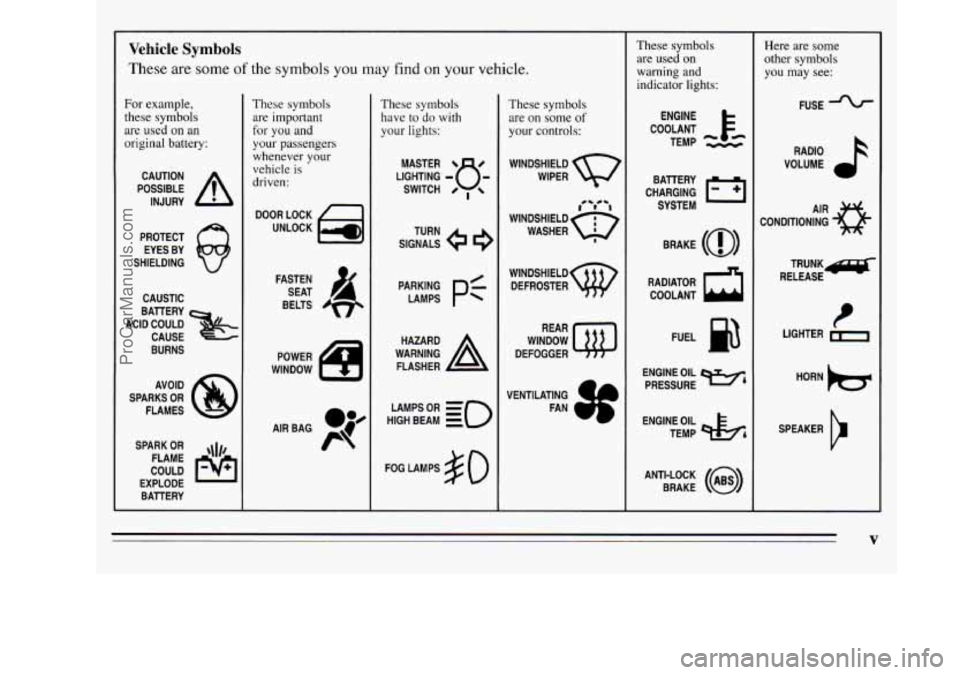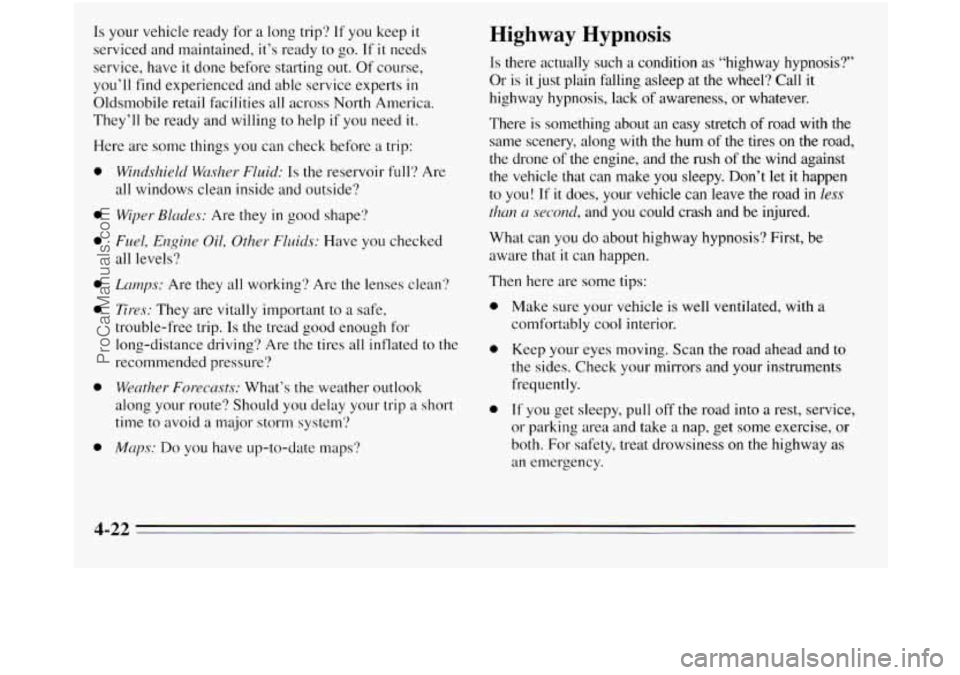Page 9 of 390

L
Vehicle Symbols
These are some of the symbols you may find on your vehicle.
For example,
these symbols are used on an
original battery:
POSSIBLE A
CAUTION
INJURY
PROTECT EYES BY
SHIELDING
CAUSTIC
ACID COULD BAlTERY
CAUSE
BURNS
AVOID
SPARKS
OR
FLAMES
SPARK
OR ,111,
COULD FLAME
EXPLODE BAllERY
These symbols are important
for you and
your passengers whenever your
vehicle is
driven:
DOOR LOCK
UNLOCK
FASTEN SEAT
BELTS
POWER
WINDOW
These symbols have to do with
your lights:
SIGNALS e e3
TURN
WARNING
A
HAZARD
FLASHER
HIGH
LAMPSoR BEAM = zo
FOG LAMPS $0
These symbols
are on some
of
your controls:
WINDSHIELD
WIPER
WINDSHIELD DEFROSTER
WINDOW
DEFOGGER
VENTILATING FAN
These symbols are used on
warning and
indicator lights:
COOLANT F-
TEMP --
ENGINE
CHARGING BAllERY
SYSTEM
BRAKE
(a)
RADIATOR COOLANT
a
FUEL
ENGINE OIL
PRESSURE
w4
TEMP OIL pk;
ANTI-LOCK (a)
BRAKE
Here are some
other symbols
you may see:
FUSE
RADIO
VOLUME
CONDITIONING
43
TRUNX~
RELEASE
HORN
)tr
SPEAKER
b
V
ProCarManuals.com
Page 98 of 390
I NOTICE: I
After you’ve used the coolant heater, be sure to store the cord as it was before to keep it away
from moving engine parts.
If you don’t, it could
be damaged.
~~ ~ ~ - ~
How long should you keep the coolant heater plugged in?
The answer depends on the weather, the kind of oil you have,
and some other things. Instead
of trying to list everything
here, we
ask that you contact your Oldsmobile retailer in the
area where you’ll be parking your vehicle. The retailer can \
give you the best advice for
that particular area.
Shifting the Automatic Transaxle
There are several different positions for your shift lever.
R NOD21 1
2-28
ProCarManuals.com
Page 143 of 390
1. Low Traction Light (Option: 3800 V6)
2. Air Bag Readiness Light
3. Malfunction Indicator Lamp
(Service Engine Soon Light)
4. Power Sliding Door Warning Light (Option)
5. Liftgate Ajar Warning Light
6. Brake System Warning Light
7. Voltmeter
8. Oil Pressure Gage
9. Tachometer
10. Safety Belt Reminder Light
11. Right Turn Signal 12.
Anti-Lock Brake System Warning Light
1 3. Speedometer 14. High Beam Indicator
15. Traction Control System Warning Light
(Option: 3800
V6)
16. Left Turn Signal
17. Odometer
18. Trip Odometer Reset Button
19. Trip Odometer
20. Fuel Gage
21. Low Fuel Warning Light
22. Engine Coolant Temperature Gage
2-73
ProCarManuals.com
Page 152 of 390
Oil Pressure Indicator (3.1L V6 Engine)
H /
Your vehicle is equipped with an oil pressure indicator
rather than an oil pressure gage. Your oil pressure
indicator lets you know when
you may have a problem
with your engine oil pressure.
When the engine is running, readings within the white
area indicate the normal operating range. Readings
in or
below the red area indicate that the engine’s oil level may
be dangerously low, or there may be another
problem causing low oil pressure.
Driving your vehicle with low oil pressure can cause
extensive engine damage. Have your vehicle serviced
immediately.
I NOTICE:
Damage to your engine from neglected oil
problems can be costly and is not covered by your
warranty.
2-82
ProCarManuals.com
Page 153 of 390
Oil Pressure Gage (3800 V6 Engine)
120 '/
40-
If the gage reads in the red warning zone, your engine's
oil level may be dangerously low or there may be
another problem causing low oil pressure.
Driving your vehicle with low
oil pressure can cause
extensive engine damage. Have your vehicle serviced
immediately.
Your oil pressure gage shows the oil pressure in psi
(pounds per square inch) when the engine is running.
Oil pressure may vary with engine speed, outside
temperature and oil viscosity. In fact, while the engine is
warming up, the oil pressure will be higher than at the
normal operating temperature. Readings above the red
warning zone indicate the normal operating range.
I
I NOTICE:
Damage to your engine from neglected oil
problems can be costly and is not covered by
your warranty.
2-83
ProCarManuals.com
Page 204 of 390

Is your vehicle ready for a long trip? If you keep it
serviced and maintained, it’s ready to go. If it needs
service, have
it done before starting out. Of course,
you’ll find experienced and able service experts in
Oldsmobile retail facilities all across North America.
They’ll be ready and willing
to help if you need it.
Here are some things you can check before a trip:
0
a
a
0
a
a
0
Windshield WLzslzer Fluid: Is the reservoir full? Are
all windows clean inside and outside?
Wiper Blades: Are they in good shape?
Fuel, Engine OiL, Other Fluids: Have you checked
all levels?
Lcmys: Are they all working? Are the lenses clean?
Tires: They are vitally important to a safe,
trouble-free trip.
Is the tread good enough for
long-distance driving? Are
the tires all inflated to the
recommended pressure?
Weather Forecasts: What’s the weather outlook
along your route? Should
you delay your trip a short
time to avoid a major storm system‘?
Maps: Do you have up-to-date maps‘?
Highway Hypnosis
Is there actually such a condition as “highway hypnosis?’
Or is it just plain falling asleep at the wheel? Call it
highway hypnosis, lack
of awareness, or whatever.
There
is something about an easy stretch of road with the
same scenery, along with the hum of the tires on the road,
the drone of the engine, and the rush
of the wind against
the vehicle that can make you sleepy. Don’t
let it happen
to you! If
it does, your vehicle can leave the road in less
than u second, and you could crash and be injured.
What can you do about highway hypnosis? First, be
aware that it can happen.
Then here are some tips:
0
0
0 Make sure your vehicle is well ventilated, with a
comfortably cool interior.
Keep your eyes moving. Scan the road ahead and
to
the sides. Check your mirrors and your instruments
frequently.
If you get sleepy, pull
off the road into a rest, service,
or parking area and take
a nap, get some exercise, or
both. For safety, treat drowsiness on the highway as
an emergency.
4-22
ProCarManuals.com
Page 220 of 390

could start to move. People can be injured, and both
your vehicle and the trailer can be damaged.
But
if you ever have to park your rig on a hill, here’s
how to
do it:
1. Apply your regular brakes, but don’t shift into
PARK
(P) yet.
2. Have someone place chocks under the trailer whe
3. When the wheel chocks are in place, release the
regular brakes until the chocks absorb the load. els.
Parking on Hills
You really should
not park your vehicle, with a trailer
attached, on
a hill. If something goes wrong, your rig
4. Reapply the regular brakes. Then apply your parking
brake, and then shift to PARK
(P).
5. Release the regular brakes.
When You Are Ready to Leave After
Parking
on a Hill
1. Apply your regular brakes and hold the pedal down
while you:
0 Start your engine;
0 Shift into a gear; and
Release the parking brake.
2. Let up on the brake pedal.
3. Drive slowly until the trailer is cl
ear of the chocks.
4. Stop and have someone pick up and store the chocks.
Maintenance When Trailer Towing
Your vehicle will need service more often when you’re
pulling
a trailer. See the Maintenance Schedule for more
on this. Things that are especially important in trailer
operation are automatic transaxle fluid (don’t overfill),
engine
oil, belts, cooling system, and brake adjustment.
Each
of these is covered in this manual, and the Index
will help you find them quickly. If you’re trailering, it’s
a good idea to review these sections before you start
your trip.
Check periodically to see that
all hitch nuts and bolts
are tight.
4-3s
ProCarManuals.com
Page 239 of 390
3800 V6: Cooling System
When you decide it’s safe to lift the hood, here’s what
you’ll see: If
the coolant inside the coolant recovery tank is boiling,
don’t do anything else until it cools down.
(A) Coolant recovery tank
(B) Radiator pressure cap
(C) Electric engine fan (or fans if you have the 3800 V6
engine).
3.1L V6: Recovery Tank Level
5-17
ProCarManuals.com